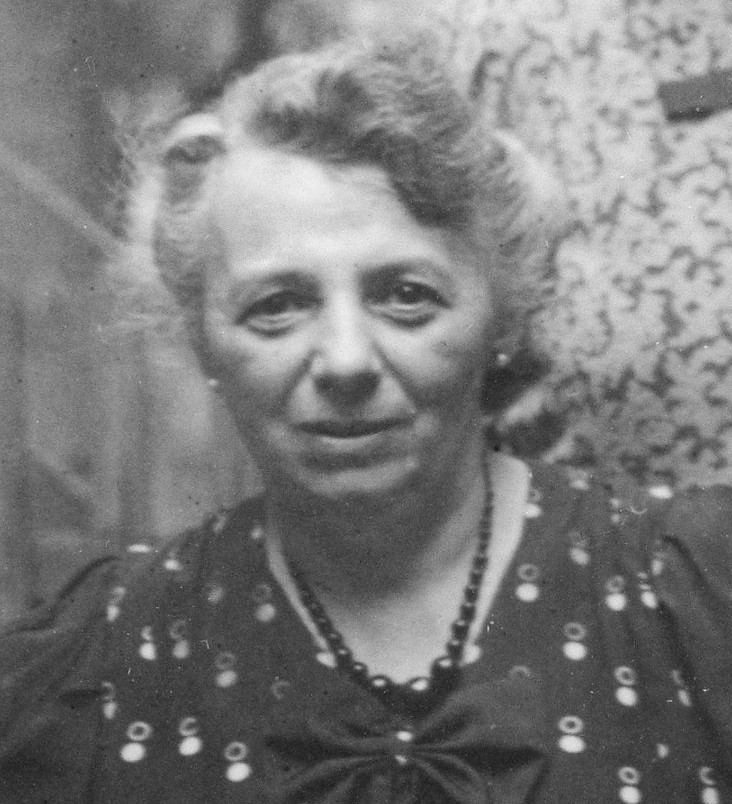Search for Names, Places and Biographies
Already layed Stumbling Stones
Suche
Anna Weinstein (née Neufeld) * 1881
Schloßmühlendamm 16 (Harburg, Harburg)
1941 Lodz
ermordet
further stumbling stones in Schloßmühlendamm 16:
Helene Chaja Wellner, Hermann Wellner, Samuel Wellner, Josef Wellner
Anna Weinstein, née Neufeld, b. 5.3.1881 in Harburg, deported to Lodz on 10.25.1941, date of death unknown
City District Harburg-Altstadt, Schlossmühlendamm 16
Anna Neufeld was the oldest daughter of the Jewish businessman, currency, and real estate broker, Max Neufeld (9.4.1851–9.24.1925) and his wife Jenny, neé Pintus (9.4.1859–12.28.1940). Like her two younger brothers Paul (6.14.1885) and Erich (10.11.1891) and her three sisters Gertrud (3.29.1883), Käthchen (6.10.1887) and Hedwig (9.19.1890), she spent her childhood in Harburg where her father owned a house at Mühlenstrasse 18 (today, Schlossmühlendamm 16) and served for several years as the first superintendent of the Jewish Congregation.
Her brother Erich fought for Germany in the First World War and died a non-commissioned officer off the French coast of the English Channel near Carvin on 11 May 1915; he was 24 years old. His name is on a monument for Jewish soldiers from Harburg who fell during the war, erected in the city’s Jewish cemetery in 1921. His soldier’s death was memorialized also on the grave stone of his father, buried there four years later.
Even before World War I, Anna Neufeld had left her home in Harburg and moved to Jever in East Frisia, where she married Joshua Weinstein, a Jewish grain wholesaler who also represented manufacturers of milling products. The young couple lived at Bahnhofstrasse 39 and rejoiced at the birth of their daughter Liselott in 1907. The death of Joshua Weinstein on 8 November 1926 was not only a great human loss for the family, but also a heavy economic blow. Anna Weinstein responded to the new situation by completely separating herself from the grain wholesaling business and concentrating on the representation of concerns making milling products; in this she was increasingly supported by her daughter. This activity was apparently so profitable that she was able to maintain her former life style more or less intact.
It did not take long after Hitler’s naming as Reich Chancellor before the basis for Anna Weinstein’s life style to be severely impacted. Several customers sought new business partners, dramatically diminishing her sales. On 3 June 1936, the Holsatia Mühlen, Inc. in Kiel, the most important of Anna Weinstein’s partners, ended collaboration with her because political conditions had changed. The development to allow "only Aryan firms work in the Reich Food Estate, [was] unstoppable.” As compensation Anna Weinstein was assured of receiving a payment of 150 RM per month. During the pogrom days of November 1938, Anna Weinstein was briefly arrested and intensively interrogated by the Gestapo, which also conducted a house search, confiscating a part of her jewelry and a large quantity of cash.
When the Jewish population of Germany, following the events of 9 and 10 November 1938, had to make an "atonement” payment for the attendant damages amounting to a billion RM, all Jews had to contribute proportionately to their wealth; Anna Weinstein was also affected by this. To come up with the balance of what she owed, she had to sell her house in Jever at very unfavorable valuation. The remainder of her assets were put under a "security order,” that is, the owner of the account, aside from a monthly allowance of 150 RM for living expenses, had disposal over the funds only with the approval of the responsible chief financial governor.
When her daughter left her home city in May 1939 for England, Anna Weinstein, 58 years old, remained alone back in Jever. Under these circumstances, she had no particular reasons to remain in East Frisia. A year before her very aged mother died, she returned to her parental home at Mühlenstrasse 18 in Harburg in the summer of 1939. The "repatriate” became a member of the Reich Association of Jews in Germany, district office for Northwest Germany, in which all Jews had to become members. Her yearly contribution was 12 RM.
On 25 October 1941, Anna Weinstein was among the Hamburg Jews to be deported to the East. She had previously, as prescribed, handed in her apartment key to the nearest police station in Harburg. Her property and her dwelling at Mühlenstrasse 18 fell to the German Reich after her evacuation. Anna Weinstein’s large 5-room apartment on the second floor of the house was soon occupied by a Harburg middle school teacher and his family, while the expropriated owner was in Lodz ghetto at Hohensteiner Strasse 51, a primitive lodging of most limited space which she shared with several other complete strangers. All the rooms were unheated; there was no running water. Bedbugs were everywhere.
Only four people from this first Hamburg deportation transport survived the Shoah. Anna Weinstein was not one of them. The precise circumstances of her death are not known. On 22 Juni 1952, she was declared dead by the Harburg District Court as of 31 December 1945. Among the victims of the Shoah were also her sisters Hedwig Mamsohn, née Neufeld, and Käthchen Hirschfeld, née Neufeld, along with her husband Isidor Hirschfeld.
Translator: Richard Levy/Changes Beate Meyer
Kindly supported by the Hermann Reemtsma Stiftung, Hamburg.
Stand: June 2020
© Klaus Möller
Quellen: 1; 2 (R 1940/447); 4, 5; 8; StaH 351-11, AfW, Abl. 2008/1, 020807 Spitzer, Liselott; Heyl (Hrsg.), Harburger Opfer; Heyl, Synagoge; Kändler/Hüttenmeister, Friedhof, S. 200; Peters, Verbannte Bürger; email Holger Frerichs v. 14.6.2020;
Zur Nummerierung häufig genutzter Quellen siehe Link "Recherche und Quellen".


